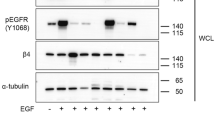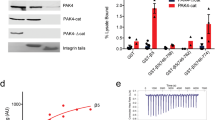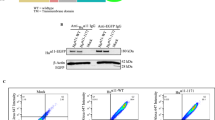Abstract
Disruption of integrin-extracellular matrix interactions in normal epithelial cells induces apoptosis, a process termed anoikis. Reduced sensitivity to anoikis appears to be an important hallmark of oncogenic transformation, particularly in the process of metastasis. Several pathways have been implicated in the suppression of anoikis, however, the events which take place proximal to the integrin receptors remain unclear. Integrin-linked kinase (ILK) is an integrin-interacting protein kinase which has been identified as a potential PDK-2, as it is capable of phosphorylating PKB/Akt on Ser-473, and stimulating its activity. Here, we show that ILK activity is stimulated upon adhesion of SCP2 mouse mammary epithelial cells to fibronectin, and inhibited in suspended cells. Overexpression of ILK in the anoikis-sensitive SCP2 cells results in a profound inhibition of anoikis, as determined by annexin V binding and activation of caspases 8 and 3. This effect is reversible by the transfection and expression of a dominant-negative, kinase deficient ILK (ILK KD), as well as by a dominant negative PKB/Akt (PKB AAA). On the other hand, transfection of a dominant negative form of FAK (FRNK) failed to reverse the suppression of anoikis by ILK. Furthermore, inhibition of ILK activity induced anoikis in two anoikis-resistant human breast cancer cell lines. These findings suggest that ILK plays a major role in the suppression of anoikis.
This is a preview of subscription content, access via your institution
Access options
Subscribe to this journal
Receive 50 print issues and online access
$259.00 per year
only $5.18 per issue
Buy this article
- Purchase on Springer Link
- Instant access to full article PDF
Prices may be subject to local taxes which are calculated during checkout




Similar content being viewed by others
References
Balendran A, Casamayor A, Deak M, Paterson A, Gaffney P, Currie R, Downes CP and Alessi DR. . 1999 Curr. Biol. 9: 393–404.
Brunet A, Bonni A, Zigmond MJ, Lin MZ, Juo P, Hu LS, Anderson MJ, Arden KC, Blenis J and Greenberg ME. . 1999 Cell 96: 857–868.
Datta SR, Dudek H, Tao X, Masters S, Fu H, Gotoh Y and Greenberg ME. . 1997 Cell 91: 231–241.
Delcommenne M, Tan C, Gray V, Ruel L, Woodgett J and Dedhar S. . 1998 Proc. Natl. Acad. Sci. USA 95: 11211–11216.
Downward J. . 1998 Curr. Biol. 10: 262–267.
Dragovich T, Rudin CM and Thompson CB. . 1998 Oncogene 17: 3207–3213.
Frisch SM. . 1999 Curr. Biol. 9: 1047–1049.
Frisch SM and Francis H. . 1994 J. Cell Biol. 124: 619–626.
Frisch SM and Ruoslahti E. . 1997 Curr. Biol. 9: 701–706.
Frisch S, Vuori K, Kelaita D and Sicks S. . 1996a J. Cell Biol. 135: 1377–1382.
Frisch S, Vuori K, Ruoslahti E and Chan-Hui PY. . 1996b J. Cell Biol. 134: 793–799.
Hannigan GE, Leung-Hagesteijn C, Fitzgibbon L, Coppolino M, Radeva G, Filmus J, Bell JC and Dedhar S. . 1996 Nature 379: 91–96.
Khwaja A, Rodriguez-Viciana P, Wennstrom S, Warne PH and Downward J. . 1997 EMBO J. 16: 2783–2793.
Kops GJ, de Ruiter ND, DeVries-Smits AM, Powell DR, Boss JL and Burgering BM. . 1999 Nature 398: 630–634.
Kumar C. . 1998 Oncogene 17: 1365–1373.
Lu Y, Lin YZ, LaPushin R, Cuevas B, Fang X, Yu SX, Davies MA, Khan H, Furui T, Mao M, Zinner R, Hung MC, Steck P, Siminovitch K and Mills GB. . 1999 Oncogene 18: 7034–7045.
Lynch DK, Ellis CA, Edwards PA and Hiles ID. . 1999 Oncogene 18: 8024–8032.
Morimoto AM, Tomlinson MG, Nakatini K, Bolen JB, Roth RA and Herbst R. . 2000 Oncogene 19: 200–209.
Novak A, Hsu SC, Leung-Hagesteijn C, Radeva G, Papkoff J, Montesano R, Roskelley C, Grosschedl R and Dedhar S. . 1998 Proc. Natl. Acad. Sci. USA 95: 4374–4379.
Persad S, Attwell S, Gray V, Delcommenne M, Troussard A, Sanghera J and Dedhar S. . 2000 Proc. Natl. Acad. Sci. USA 97: 3207–3212.
Radeva G, Petrocelli T, Behrend E, Leung-Hagesteijn C, Filmus J, Slingerland J and Dedhar S. . 1997 J. Biol. Chem. 272: 13937–13944.
Romashkova JA and Makarov SS. . 1999 Nature 401: 86–90.
Ruoslahti E and Reed J. . 1994 Cell 74: 477–478.
Rytomaa M, Martins ML and Downward J. . 1999 Curr. Biol. 9: 1043–1046.
Stambolic V, Suzuki A, de la Pompa JL, Brothers GM, Mirtsos C, Sasaki T, Ruland J, Penninger JM, Siderovski P and Mak TW. . 1998 Cell 95: 29–39.
Troussard A, Tan C, Yoganathan N and Dedhar S. . 1999 Mol. Cell. Biol. 19: 7420–7427.
Williams MR, C Arthur JS, Balendran A, van der Kaay J, Poli V, Cohen P and Alessi DR. . 2000 Curr. Biol. 10: 439–448.
Zhao JH, Reiske H and Guan JL. . 1998 J. Cell Biol. 143: 1997–2008.
Acknowledgements
We thank Kristina Vouri for the FRNK expression plasmid, and Kinetek Pharmaceuticals (Vancouver, Canada) for providing the ILK inhibitor, KP-SD1. This work was supported by grants to S Dedhar from the National Cancer Institute of Canada (NCIC). S Attwell is a recipient of a University Graduate Fellowship (UGF) from the University of British Columbia.
Author information
Authors and Affiliations
Rights and permissions
About this article
Cite this article
Attwell, S., Roskelley, C. & Dedhar, S. The integrin-linked kinase (ILK) suppresses anoikis. Oncogene 19, 3811–3815 (2000). https://doi.org/10.1038/sj.onc.1203711
Received:
Revised:
Accepted:
Published:
Issue Date:
DOI: https://doi.org/10.1038/sj.onc.1203711
Keywords
This article is cited by
-
Integrin-linked kinase (ILK): the known vs. the unknown and perspectives
Cellular and Molecular Life Sciences (2022)
-
New cell delivery system CellSaic with adipose-derived stromal cells promotes functional angiogenesis in critical limb ischemia model mice
Journal of Artificial Organs (2021)
-
Role of α- and β-adrenergic signaling in phenotypic targeting: significance in benign and malignant urologic disease
Cell Communication and Signaling (2021)
-
Identification of a novel anoikis signalling pathway using the fungal virulence factor gliotoxin
Nature Communications (2018)
-
Integrin and FAK Regulation of Human Pluripotent Stem Cells
Current Stem Cell Reports (2017)



